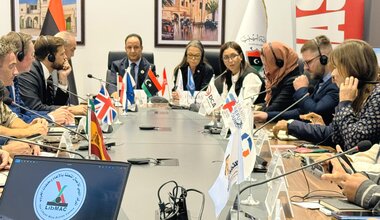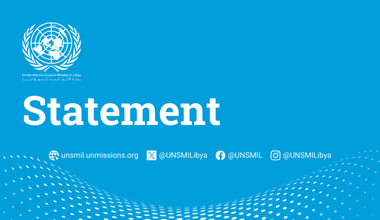Human Rights Report on Civilian Casualties - August 2018
Tunis, 4 September 2018 – From 1 August to 31 August 2018, the United Nations Support Mission in Libya (UNSMIL) documented 25 civilian casualties –22 deaths and three injuries – during the conduct of hostilities across Libya. Victims included 14 men, two woman, four boys and two girls killed, and two men and one woman injured. The actual number of civilian casualties is believed to be higher. UNSMIL continues to seek to confirm additional civilian casualties in the course of ongoing hostilities in Tripoli.
The majority of civilian casualties were caused by gunfire (three killed and three injured), followed by shelling (five killed) and explosive remnants of war (ERW, one killed). The exact causes of death of the 14 other fatalities were unknown.
UNSMIL documented civilian casualties in Tripoli (19 killed and one injured), Derna (two killed) and al-Zawiya (one killed and two injured).
UNSMIL documented five additional casualties from other possible violations of international humanitarian law and violations or abuses of international human rights law in al-Ajilat, Benghazi, Derna and Tobruq.
Civilian Casualty Incidents
Al-Zawiya
On 1 August, the use of indiscriminate fire during armed clashes between members of the Criminal Investigations Department-Surman and al-Zawiya based armed groups led to a civilian death and two civilian injuries.
Derna
On 8 August, a 15-year-old girl sustained a fatal gunshot wound while at home in al-Maghar neighbourhood, near the area of active fighting between the Libyan National Army and the Derna Protection Force (previous known as Derna Mujahideen Shura Council).
On 28 August, a 15-year-old boy was killed when an unknown explosive detonated in the area of Mbakh (also known as Hay al-Salam), which witnessed fighting in May-June 2018.
Tripoli
Armed confrontations in the southern outskirts of Tripoli between al-Kaniyat armed group and the Tripoli Revolutionary Brigade and their respective allies, which escalated since 26 August, resulted in at least 19 civilian deaths and an injury. Parties to the conflict endangered civilians through their use of weapons with wide-area impact, including rockets, tanks and other artillery, in densely-populated residential areas. A mother and her four-year-old daughter and two-year-old son sustained fatal shrapnel injuries when their home in the area of Wadi al-Rabi’ was shelled on 28 August. On 29 August, a 22-year-old woman was killed, when her home in Qasr Ben Ghashir was hit by an unknown projectile. On 30 August, two boys, aged 11 and 9, sustained fatal shrapnel wounds when their home in their area of Arada was shelled.
Civilian facilities
On 1 August, the Ibn Issa Martyrs school in al-Zawiya was hit twice during armed clashes. No casualties were reported, and students were evacuated to safety.
A mosque in Tripoli was damaged during the shelling of the Khilat al-Firjan neighborhood in late August.
Attribution
It was impossible to determine with certainly which parties to the conflict were responsible for civilian casualties in August.
Casualties from other possible violations of international humanitarian law and violations or abuses of human rights
On 4 August, the bodies of twin brothers, aged 20, were found in al-Ajilat. They had gone missing days prior, allegedly from the road. The causes of their death remain unclear, as the bodies were reportedly in a state of decomposition.
On 5 August, a 24-year-old man sustained a gunshot wound when a brawl at a Benghazi resort escalated into an exchange of fire.
On 14 August, a parliamentarian and a member of the security forces sustained gunshot wounds during a session on the referendum law held at the House of Representatives in Tobruq.
On 28 August, a three-year-old boy was killed by random fire in the neighborhood of Bab Tobruq in Derna. There were no clashes in the vicinity, and the source of fire remained unknown.
Note
The figures for civilian casualties set out above only include persons killed or injured in the course of hostilities and who were not directly participating in the hostilities. The figures do not include those casualties that are not a direct result of hostilities, for example executions after capture, torture or abductions, or casualties caused as an indirect consequence of hostilities. The figures are based on information UNSMIL has gathered and cross-checked from a broad range of sources in Libya, including human rights defenders, civil society, current and former officials, employees of local governments, community leaders and members, witnesses, others directly affected and media reports. In order to assess the credibility of information obtained, where possible, UNSMIL reviewed documentary information, including medical records, forensic reports and photographic evidence.
The figures are only those that UNSMIL was able to document in the reporting period. They are not likely to be complete and may change as new information emerges about incidents involving civilian casualties that took place during this period.
Similarly, while UNSMIL has systematically tried to ensure that the cases it documented are based on credible information, further verification would be required to attain a higher standard of proof. Due to the security situation, UNSMIL has not been able to carry out direct site visits to all relevant locations in Libya to obtain information. Fear of reprisals against sources further hamper information gathering.
While not all actions leading to civilian casualties breach international humanitarian law, UNSMIL reminds all parties to the conflict that they are under an obligation to target only military objectives. Direct attacks on civilians as well as indiscriminate attacks – which do not distinguish between civilians and fighters – are prohibited. Attacks that are expected to cause incidental loss of civilian life, injury to civilians and damage to civilian objects excessive to the anticipated concrete and direct military advantage are also prohibited. Such attacks amount to war crimes that can be prosecuted by the International Criminal Court.
In order to ensure greater protection of the civilian population and essential infrastructure, all parties engaged in fighting in Libya must cease the use of mortars and other indirect weapons and imprecise aerial bombardments in civilian-populated areas, and not place fighters or other military objectives in populated areas. All executions of captives must cease and all those captured including fighters must be treated humanely in all circumstances. Murdering or torturing captives is also a war crime, regardless of what the captive may be accused of.
Cases highlighted in the “Casualties from other violations of international humanitarian law and violations or abuses of human rights” section include casualties caused during incidents that would constitute a violation of international humanitarian or human rights law, but are not a direct result of hostilities, for examples executions upon capture of civilians and others hors de combat (such as captured fighters) and torture causing death. The section also includes casualties caused by the proliferation of weapons and impunity enjoyed by armed groups and criminal networks – considered as indirect consequences of hostilities. Cases highlighted in the “casualties from other violations” section are not included in the figures for civilian casualties and include only those that UNSMIL documented during the month.
Contact UNSMIL’s Human Rights Monitoring Team to report information on civilian casualties in Libya at the following email address: unsmil-monitoringhumanrightsteam@un.org.
 United Nations Peacekeeping
United Nations Peacekeeping UN
UN









